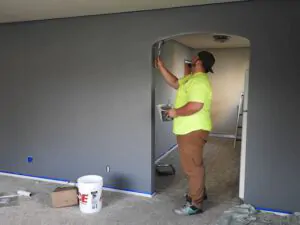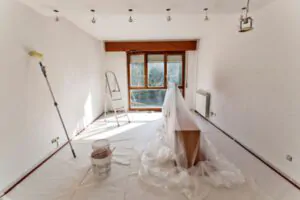Interior painting can transform your home, but did you know that the weather outside affects how paint dries inside? Many people overlook this crucial detail and miss out on achieving that flawless finish.
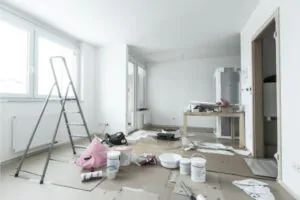
With over a decade in the painting industry, we’ve honed our painters to understand just how temperature and humidity play pivotal roles in delivering perfection. Our expertise isn’t simply about applying paint; it’s ensuring the best weather to paint inside is prime for each brush stroke.
Did you know that spring showers could leave your fresh walls with unwelcome streaks? That’s one key takeaway from our extensive experience – moisture in the air is as impactful as the quality of paint used.
Stay tuned as we dive into seasonal secrets to ensure optimal drying times and finishes year-round. Ready for expert painting tips? Let’s roll!
Spring Painting Bliss
As the weather warms up, spring is the best weather to paint inside your home. From addressing potential moisture issues to ensuring optimal drying conditions, we’ve got you covered with tips for tackling common springtime challenges.

Tips for Tackling Common Springtime Challenges
Spring offers some of the best weather to paint inside your home, but it’s not without its quirks. You’ll want to keep an eye on the forecast because spring showers bring more than just flowers—they can also mean unexpected humidity.
Start by checking the ideal temperature and humidity before painting your house interior: 50-85°F with relative humidity below 60%. Aim to paint on days that fit these parameters for optimal drying times.
Keep your space ventilated to manage moisture levels and ensure a smooth finish. Open windows can help, but be mindful of pollen count on high allergy days; you don’t want allergens sticking to your fresh paint! With these proactive strategies, you’ll tackle springtime challenges head-on and get that perfect coat of paint.
While these tips are effective during springtime, here are some other simple ones you can try at home:
· Manage Humidity Levels: Spring often brings fluctuating humidity. Use a dehumidifier to maintain optimal painting conditions and ensure proper drying of paint.
· Temperature Considerations: Aim for a moderate temperature range (typically 50-85°F or 10-29°C) for painting. Spring temperatures can be unpredictable, so plan your painting schedule accordingly.
· Ventilation is Key: Take advantage of the fresh spring air by keeping windows and doors open for ventilation. This helps in speeding up the drying process and reducing the smell of paint fumes.
· Choose Low VOC Paints: Volatile Organic Compounds (VOCs) in paints can be harmful. Opt for low VOC or zero VOC paints to create a healthier indoor environment, especially when the windows can be open for ventilation.
· Inspect and Repair Walls: Spring is an excellent time to inspect your walls for any damage caused during the winter. Repair cracks or holes before painting to ensure a smooth and even finish.
· Prep and Prime: Proper preparation is crucial. Clean walls thoroughly, remove dust or grime and use a quality primer before applying paint. This ensures better adhesion and a longer-lasting finish.
· Time Your Project: Consider the natural light in each room. Plan your painting schedule to take advantage of the daylight hours, as this makes it easier to spot imperfections and achieve a more even application.
· Watch for Allergies: Spring is allergy season, so be cautious with painting if you or your family members have allergies. Keep windows closed during high pollen times and choose low-odor paints.
· Avoid Direct Sunlight: Painting in direct sunlight can cause the paint to dry too quickly, leading to streaks and uneven coverage. Plan your painting sessions to avoid direct sunlight or use shades to control light exposure.
· Patience with Drying Times: Springtime humidity may affect the drying times of paint. Be patient between coats and follow the recommended drying times on the paint to achieve the best results.
Next up, summer has its own set of rules—let’s stay cool while maintaining top-notch results!
Summer Sunshine and Smooth Strokes
Ah, the sweet embrace of summer – the season of sunshine, clear skies, and the perfect time to give your house interior a vibrant makeover with a fresh coat of paint. As the temperature rises, so does the enthusiasm for home improvement projects, and let me tell you, painting your interiors in the summer is like giving your space a sun-kissed glow.
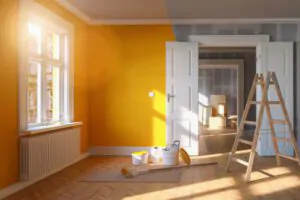
One of the summer painting perks is the glorious natural light that floods your area. It’s like having a built-in spotlight, highlighting every nook and cranny. This not only makes the painting process more enjoyable but also helps you catch any imperfections and ensure a flawless finish. Imagine those rays of sunshine dancing off your newly painted walls – it’s like an instant mood booster for your home!
Now, let’s talk about drying times. Summer’s warm embrace means quicker drying for your beloved paint. Those agonizing waits between coats? Well, they’re significantly shorter. With the sun lending a hand, you can breeze through your house painting project, transforming your living area from drab to fab in record time. Plus, the faster drying times mean less chance of accidental smudges or unwanted imprints from curious pets or little ones.
But here’s the real secret weapon of summer painting – the extended daylight hours. Say goodbye to racing against the setting sun; you’ve got ample time to perfect those edges and smooth out those strokes. It’s a painter’s dream come true.
So, grab your brushes, pick your palette, and let the summer sunshine be your artistic accomplice in creating a home that radiates warmth inside and out.
Strategies for Staying Cool and Comfortable While Painting in the Summer
- Use fans to create a cross breeze in the room you’re painting. Position them near windows or doors to push hot air out and pull cooler air in. This will not only help maintain a comfortable temperature but also ensure fumes and odors from the paint disperse quickly.
- Dress for the task by wearing lightweight, breathable clothing that won’t trap heat. Opting for moisture-wicking fabrics can make a big difference in how cool you feel as you work.
- Stay hydrated by drinking plenty of water throughout your painting project. Dehydration can sneak up on you during physical tasks, especially in warmer weather. Have an insulated water bottle on hand so cold drinks are always within reach.
- Take regular breaks to step outside or into an air-conditioned space; giving yourself time away from the humidity and heat helps keep your energy levels up and your body temperature down while tackling interior painting during summer’s peak temperatures.
Related Post: Do I Need To Move My Furniture For The Painters?
Fall – The Goldilocks Season
As the temperatures start to cool down in the fall, it can be the perfect time to tackle interior painting projects. However, it’s important to be mindful of potential temperature fluctuations and how they can affect paint application.
It’s not too hot, not too cold, it’s just right for giving your interiors a cozy, autumnal makeover. As the leaves change color and the air takes on that crisp edge, your home can undergo a transformation of its own with a fresh paint job.
One of the fall’s most significant perks is the moderate temperatures. Unlike the scorching heat of summer or the biting cold of winter, fall offers that perfect balance. Paint loves stability, and so do you. The mild temperatures mean your paint won’t dry too quickly or take forever to set, giving you the ideal window to achieve that flawless finish.
But it’s not just about the temperature – fall brings lower humidity. Say goodbye to the sticky, humid days that can wreak havoc on your painting project. Lower humidity ensures that your paint dries evenly and adheres to the walls without the risk of bubbling or cracking.
Now, let’s talk about ambiance. Fall’s warm and earthy tones create a natural backdrop for your painting endeavors. Whether you’re opting for rich reds, deep oranges, or soothing browns, the fall palette effortlessly complements the season’s aesthetic, bringing a touch of nature’s beauty
into your home.
And let’s not forget the lighting. The softer, diffused sunlight of fall casts a warm glow on your freshly painted walls, highlighting the richness of your chosen colors. It’s like having your spotlight, showcasing your home in its autumnal glory. So, embrace the Goldilocks season, grab your paintbrushes, and let the fall vibes inspire your interior transformation.
Tips for Addressing Potential Temperature Fluctuations
Fall brings unpredictable weather, so keep a close eye on the forecast to pick the best weather to paint inside your home. Ensure your space is well-ventilated, but avoid direct drafts that can cause the paint to dry unevenly.
Use a thermostat or indoor thermometer to monitor the room temperature; aim for a steady range between 60-70 degrees Fahrenheit, which is optimal for most paints.
Before you start, let paint cans acclimate in the room you’ll be working in. This helps maintain consistency since sudden temperature changes can affect how well the paint applies and adheres.
If it’s chilly outside, give your heating system a quick check to ensure it’s up to snuff and ready to keep your space within that perfect painting temperature interior zone while you work magic on your walls.
Wintertime Woes and Wins
Winter brings its own set of challenges when it comes to painting your house interior, from low air temperatures affecting paint quality to potential moisture issues.
Winter – a season often associated with cozy blankets and crackling fires, but did you know it’s also the unsung hero of interior painting? Yes, you heard it right. Winter, with its crisp air and unique set of challenges, can actually be the perfect time to breathe new life into your living space.
One of the biggest advantages of winter painting is the lower humidity levels. Unlike the sticky days of summer, winter air tends to be drier. This means your paint will dry more evenly and adhere better to the walls, creating a smooth, long-lasting finish. So, if you are a homeowner looking to avoid the potential pitfalls of humid weather, winter is your painting pal.
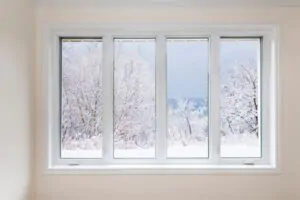
Now, let’s talk about drying times. The cool temperatures of winter may extend the time it takes for your paint to dry, but this can be a blessing in disguise. Slower drying allows for a more even application, reducing the likelihood of streaks and brush marks. Embrace the unhurried pace of winter and relish in the process of perfecting each stroke.
Winter’s natural lighting can also play in your favor. While the days may be shorter, the light is often softer and diffused, creating a flattering ambiance that showcases your paint choices in their truest form. Plus, with the holiday season in full swing, your freshly painted home becomes the perfect backdrop for festive gatherings, turning winter painting woes into wins.
That said, here are some tips on how to address these concerns and still achieve a successful indoor paint job during the colder months.
Winter Considerations for Maintaining Paint Quality
During winter, maintaining the quality of interior paint becomes crucial due to temperature and humidity fluctuations. It’s essential to ensure proper ventilation in the painting area to aid in the drying process.
Additionally, using a dehumidifier can help control indoor humidity levels, preventing moisture-related issues that could affect paint adhesion and durability. Keep in mind that applying paint during cold temperatures can lead to longer drying times, so it’s important to allow for ample drying time between coats.
To maintain optimal paint quality during winter, consider using low-temperature specific paints. These formulations are designed to perform well even in colder conditions, ensuring a smooth finish without compromising durability or longevity.
You might like: A Guide To Hiring A Painting Contractor For Your Project
Ready to Transform Your Space? Contact Us for Experts Interior Painting Advice!
Discover the ideal painting conditions for each season. Implement practical tips to achieve efficient and effective results. How can you apply these strategies in your next interior painting project? Emphasize the importance of choosing the right weather conditions for successful outcomes.
Explore additional resources or services to enhance your painting experience. Take the first step toward transforming your space with expert guidance and support from our team! Ready to elevate your interior with a fresh coat of paint? Let’s discuss your project and find the best weather to paint inside your home for a stunning finish!
Conclusion
Experience a hassle-free interior painting project year-round by leveraging the best weather to paint inside your home for each season. Avoid common pitfalls and achieve professional results through practical strategies tailored to the specific challenges of spring, summer, fall, and winter.
Embrace these easy-to-implement tips to ensure your painting experience remains efficient and effective regardless of the season. By considering the impact of weather on paint application, you can elevate your approach and navigate seasonal nuances with confidence.
Seek further guidance from our team of house painters at South Shore Painting Contractors to optimize your interior painting endeavors and transform your living spaces effortlessly. Unleash the potential of every season for flawless interior painting that reflects your style and vision.





